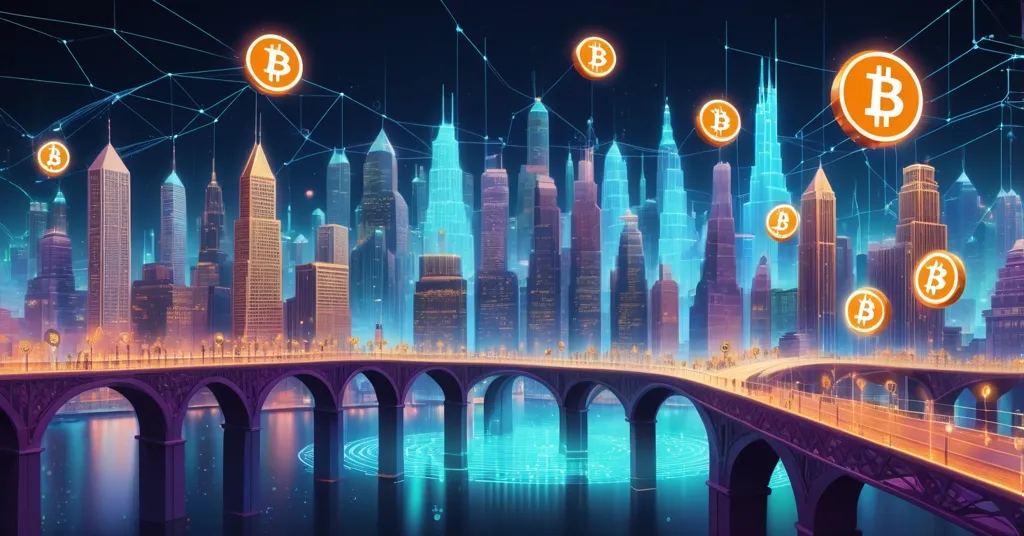Tokenized RWAs Surge to $60B as Bitcoin Breaks $112K, Fueling Onchain Finance

Tokenized Real-World Assets (RWAs): Fueling the Onchain Finance Revolution as Bitcoin Hits $112K
Bitcoin smashing through $112,000 has the crypto sphere on fire, but the real game-changer is the explosive rise of tokenized Real-World Assets (RWAs), hitting a $60 billion market cap with eyes on $80 billion. This isn’t just another hype cycle—RWAs are rewriting the rules of finance by dragging traditional assets onto the blockchain, promising a future where everyone, not just the elite, can own a piece of the pie.
- RWA Boom: Tokenized assets reach $60B market cap, targeting $80B with institutional and structural tailwinds.
- Bitcoin Milestone: BTC surges past $112K, sparking market-wide optimism and capital flow into altcoins.
- Altcoin Surge: TOTAL3 market cap (excluding BTC and ETH) hits $938.6B with an 11.19% weekly gain, signaling a potential altcoin season.
Bitcoin’s $112K Rally: A Catalyst for Crypto Confidence
Let’s start with the big dog. Bitcoin crossing $112K isn’t just a number—it’s a psychological sledgehammer, shattering doubt and pumping confidence into every corner of the crypto market. This price discovery phase, where BTC charts new highs, acts like a rising tide lifting all boats. It’s not just hodlers cheering; this momentum is pushing capital into riskier bets like altcoins and innovative sectors like RWAs. When Bitcoin roars, the market listens, and right now, it’s screaming optimism, with a significant impact on tokenized assets. But let’s not get drunk on the hype—Bitcoin’s history of gut-wrenching drops, like the 8.46% daily plunge seen in 2023, reminds us that volatility is the name of the game. This rally is a spark, not a guarantee.
What Are Tokenized Real-World Assets and Why Do They Matter?
Imagine a world where owning a skyscraper in New York or a government bond isn’t just for millionaires. That’s the magic of Real-World Assets (RWAs). These are tangible things—real estate, commodities, corporate bonds, even fine art—digitized on blockchains as tokens. Think of it like slicing a pizza: you don’t need to buy the whole thing; a single slice is yours for the taking through fractional ownership. This process, commonly known as tokenization of real-world assets, transforms illiquid, hard-to-access investments into digital assets tradable 24/7 with transparency that makes Wall Street’s shady backroom deals look like a cheap magic trick—full of smoke, mirrors, and a desperate “trust me.”
The RWA sector’s market cap, pegged at $60 billion by the Real World Asset Watchlist, has snapped out of a long consolidation with trading volumes spiking and institutional players piling in. It’s a bridge between traditional finance (TradFi) and decentralized finance (DeFi), cutting out middlemen, slashing transaction costs, and opening doors for retail investors. Blockchain real estate investment, for instance, lets you buy a stake in a property for a fraction of the cost, while tokenized bonds offer yields without the bureaucratic headache. The potential is massive—projected to hit $80 billion soon, as highlighted in recent reports on RWA transforming onchain finance—but it’s not without thorns, as we’ll dig into later.
Stablecoins: The RWA Success Story Already in Play
If you’re wondering how RWAs are already working, look no further than stablecoins. These digital currencies, often pegged to fiat like the US dollar or backed by assets such as US Treasury bills, are the poster children of tokenization. Heavyweights like Tether (USDT) and USDC handle trillions in annual settlement volume, acting as the grease in crypto’s engine. They’re a practical link between old-school fiat systems and the wild west of blockchain, making payments and trades seamless. USDT alone processed over $1.3 trillion in transactions in 2022, as detailed in stablecoin settlement volume stats for 2024, though controversies around its reserve transparency are a nagging shadow. Still, stablecoins prove RWAs aren’t a future fantasy—they’re a present reality, laying the groundwork for broader adoption of tokenized assets with their critical role in the RWA market.
Altcoin Season: Speculative Hype vs. RWA Substance
Zooming out, the broader crypto market is buzzing. The TOTAL3 index, which tracks the market cap of all cryptocurrencies except Bitcoin and Ethereum to gauge altcoin strength, has soared to $938.6 billion with a scorching 11.19% weekly gain—one of the best performances this year. Technically, it’s punched above the 50-week moving average of $798 billion, with support from the 200-week and 100-week averages hinting at a macro uptrend. In plain English? We’re flirting with a full-on altcoin season, where capital flows from Bitcoin’s safe haven into smaller, spicier assets.
Driving this rally are narratives like Solana-based meme coin ecosystems—think digital casino chips for the degenerate gambler—and Decentralized Physical Infrastructure Networks (DePIN), which are blockchain projects powering real-world systems like energy grids or internet networks, blending crypto with tangible utility. While these add flavor to the altcoin surge, RWAs stand apart as the grown-up choice in this circus of speculation. They offer yield and stability, not just Twitter memes and pump-and-dump schemes. Yet, history—like the 2023 altcoin pumps of Rollbit Coin (+6,511.11%) and Bonk (+5,074.51%)—shows how fast attention can shift to the next shiny distraction. RWAs must compete with this noise for capital and mindshare.
Institutional Buy-In: RWAs as the Safe Bet for Big Money
Here’s where RWAs shine brightest: they’re catnip for institutions. Unlike meme coins that make hedge fund managers cringe, tokenized assets tied to real-world value offer a familiar risk-reward profile. A 2023 Coinbase survey found 64% of digital asset investors planning to up their allocations within three years, while 45% of non-invested institutions eye entry in the same window, supported by data on RWA market cap growth and institutional adoption trends. Heavyweights like BlackRock and Fidelity, managing over $20 trillion in assets, are already in the game with crypto ETF filings and tokenized fund launches. BlackRock’s moves alone could funnel billions into RWAs over the next decade.
For these big players, RWAs are a gateway—less volatile than Bitcoin, more structured than DeFi yield farms. They’re not just betting on crypto; they’re betting on blockchain real estate investment, tokenized credit instruments, even carbon credits. This isn’t retail FOMO; it’s calculated strategy. But let’s play devil’s advocate: are RWAs truly revolutionary, or just TradFi in crypto drag? Critics argue they could centralize power back to institutions, clashing with blockchain’s decentralized ethos. Fair point, yet the counter is clear—RWAs democratize access, letting the little guy invest alongside the suits, all while keeping transactions transparent on-chain.
Regulatory Roadblocks and Green Lights for RWAs
Now, let’s talk red tape. The RWA boom hinges on regulation, and the picture is a mixed bag. In Europe, the Markets in Crypto-Assets (MiCA) framework offers a clear playbook—structured rules for crypto markets, especially stablecoins, giving tokenized assets a legal runway to operate. It’s a green light that could make the EU a hub for RWA innovation. Contrast that with the US, where the SEC and CFTC are locked in a turf war, creating a regulatory minefield that could detonate RWA projects before they even launch, as explored in recent updates on regulatory clarity for RWAs in major jurisdictions. Global disparities mean a project thriving in Brussels might drown in Washington’s bureaucracy.
Regulation isn’t just a speed bump; it’s a make-or-break factor. Early tokenization efforts, like some Ethereum-based real estate platforms in 2017-2018, stumbled under unclear rules or outright scams. Without trust, RWAs are dead in the water. MiCA’s clarity is a start, but until the US sorts its mess—and don’t hold your breath—global adoption will be uneven. Add to that the tech itself: blockchains like Ethereum still grapple with high gas fees during peak usage, a scalability snag that could choke mass RWA adoption unless layer-2 solutions like Arbitrum step up. One hack or compliance flop, and the trust built over years could vanish overnight, a concern echoed in discussions on RWA tokenization challenges.
Who Benefits from RWAs? A Broader Impact
Beyond the hype, let’s break down who stands to gain. First, retail investors—you and me—get access to high-value assets previously locked behind velvet ropes. A $100 stake in a tokenized property? Done. Next, institutions tap new revenue streams, packaging RWAs into products for their clients while hedging crypto’s wild swings. Even governments could play ball—imagine tokenized bonds funding public projects, cutting costs and boosting transparency. Rwanda’s tokenized bond issuances in recent years hint at this potential. RWAs aren’t just a crypto niche; they’re a financial disruptor with tentacles reaching far beyond digital wallets, and for those curious about the mechanics, there are detailed explanations on how tokenized real-world assets function.
Bitcoin Maximalism Meets Altcoin Utility
As a Bitcoin maximalist at heart, I’ll say it loud: BTC is the ultimate store of value, the digital gold that anchors this space. Its $112K milestone proves its staying power. But let’s be real—Bitcoin isn’t built for everything. Complex smart contracts powering RWA tokenization? That’s Ethereum’s turf, along with layer-2s and other chains filling niches BTC doesn’t touch. Solana’s meme coin chaos and DePIN’s real-world experiments add diversity to the ecosystem. RWAs, often built on these altcoin platforms, aren’t a threat to Bitcoin—they’re a complement, proving crypto can be more than a speculative asset. This balance is key to the revolution we champion.
RWAs in 2030: Vision and Caution
Peering into the future, RWAs could redefine ownership by 2030. Picture this: your car as an NFT, earning rental yield on a blockchain marketplace. Or global RWA exchanges where a farmer in Kenya tokenizes land for investors in Tokyo. This aligns with effective accelerationism—fast-tracking a borderless economy through tech. But let’s not get carried away. Past crypto hype cycles, from ICO mania to NFT bubbles, warn against blind optimism. RWAs must deliver real value, not just promises, and that means ironclad security, scalable tech, and responsible innovation. Greed or sloppy code could derail this mission faster than a Bitcoin flash crash.
Key Takeaways and Questions on RWAs and Crypto Momentum
- What’s behind the Real-World Asset tokenization surge?
Investor hunger for blockchain-backed assets with real-world value, improved onchain infrastructure, regulatory progress in regions like the EU, and institutional demand for yield and transparency are propelling RWA growth to a $60 billion market cap. - How do RWAs link traditional finance to blockchain?
By digitizing assets like real estate and bonds, RWAs allow fractional ownership, 24/7 trading, and on-chain transparency, merging TradFi’s established systems with DeFi’s disruptive principles. - Why are stablecoins pivotal to the RWA narrative?
Pegged to fiat or backed by assets like US Treasury bills, stablecoins like USDT and USDC process trillions yearly in transactions, serving as a proven bridge between fiat economies and crypto ecosystems. - What does the altcoin market breakout signify for crypto?
The TOTAL3 index hitting $938.6 billion with an 11.19% weekly gain points to a potential altcoin season, reflecting investor confidence and capital rotation into varied sectors like RWAs, DePIN, and Solana meme coins, hinting at market maturation. - What challenges could stall RWA momentum?
Regulatory chaos, especially in the US, blockchain scalability issues with high fees, and risks of hacks or compliance failures could erode trust and slow the adoption of tokenized assets, despite the bullish outlook.



